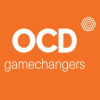
By Jessica Serber, M.A.
If you’re in Exposure and Response Prevention (ERP) for OCD, you are a brave soul. I don’t say this because ERP is ineffective, unfeasible, or even too hard for people to do. Quite the opposite, actually. ERP is evidence-based, highly effective, and the first line treatment for OCD. It does, however, ask individuals to defy intuition, something we are naturally compelled to rely on when anxious. This takes a whole lot of courage.
Let’s break it down.
Our autonomic nervous system automatically regulates many of our bodily processes, such as blood pressure and breathing, and supplies many of our internal organs with what they need to function. One part of this system, the sympathetic nervous system, is what kicks in when anxiety strikes! It is responsible for the fight-flight-freeze response, priming our bodies to take needed action in dangerous or stressful situations. Obsessive Compulsive Disorder (OCD) triggers this same response – however it is not in response to true danger or threat, but rather in response to obsessions. Obsessions are intrusive, unwanted, and distressing thoughts, images, impulses, and sensations that play in an OCD sufferer’s mind over and over again. The anxiety such obsessions cause triggers that same fight-flight-freeze response our bodies rely on in true dangerous or threatening situations, but it’s doing so over a false alarm and not a true threat.
Here comes the hard part … it feels the same! So, while you may know you have OCD and understand on a logical level that obsessions are not dangerous, on an emotional and physical level it feels the same as actually encountering a true threat might. And this is why individuals with OCD perform compulsions, as a way to reduce the anxiety and sense of risk they feel around obsessions. But because there’s no actual immediate threat to fight off, the compulsions are ineffective and insufficient. What the individual with OCD is actually reacting to is uncertainty, an uncomfortable and unsettling emotional experience, but not a dangerous one. In this way, the compulsions begin to serve as a metaphorical security blanket, something that provides a sense of safety and comfort without actually doing anything to get rid of uncertainty, since uncertainty is universal and can not be gotten rid of.
People start therapy because they want to feel better. When you start ERP therapy, your therapist will start telling you not to do the things you think are helping you to feel better (that is: compulsions). Confusing, right? But we have to remember that, with OCD, the fear center in your brain is misfiring. And the compulsions reinforce those fears each time you engage in them. The compulsions are the problem – making fear grow, interfering with your life, taking up excessive amounts of time, getting in the way of your ability to see your own strength and resiliency – which is why your therapist is going to tell you to stop doing them.
In ERP therapy, your therapist will work with you to break this cycle and the faulty beliefs that uphold it. You will face fears (exposure) without engaging in compulsions (response prevention). Over time and with repeated exposure, this process breaks the cycle of obsessions and compulsions and individuals stop needing to engage in unhelpful safety behaviors. When starting ERP therapy though, and to varying degrees throughout therapy, it will still feel wrong and risky to do so. In addition to the fear response being activated, we are conditioned as humans to seek pleasure and avoid pain. We naturally move toward what’s comfortable and away from what’s not, so staying in the discomfort of anxiety goes against our natural instincts.
This is why ERP feels so counter-intuitive. Anxiety does not respond to logic and, when it’s there, the fear feels very real. The compulsions, though unhelpful, can be relieving in the moment. So, when all the thoughts and feelings that OCD brings are present, in full force and uncomfortable as ever, thinking about not doing the one thing you’ve landed on that just might help you feel better is not the first thing that comes to mind. Let’s be honest, it’s probably not the second or third thing that comes to mind either. (Side note with this, many people begin to experience a significant decline in the relief they experience when doing compulsions the longer their OCD goes untreated. Despite this, the behavior has become so habitual and ingrained they still feel the need to engage.)
I hope this helps explain why you might be confused about or resistant to ERP therapy even though you know that it’s the right treatment to do for OCD. Your intuition is not off, it’s just focusing on the wrong thing. When you’re engaged in the obsessive-compulsive cycle, you’re focusing on what your OCD is saying, but not how it’s working. If you step back from what it’s telling you (that x fear might really be or come true unless you do y compulsion) and look at the context in which the disorder itself operates, you can begin to see that the treatment actually makes a whole lot of sense. Over time, you will begin to respond to your experience (rather than just the logic) of resisting compulsions and tolerating anxiety being so much more helpful than being caught in the obsessive-compulsive cycle ever was. ERP will feel like taking a huge risk. It’s in this leap of faith that you will begin to unlearn what the OCD has wrongly taught you all this time and learn that you are so capable of living a full, rich, and meaningful life unshackled from the burden of endless compulsions and avoidance.

